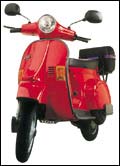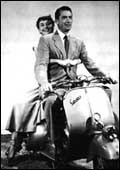|
 The
wasp's contribution to the Indian software industry is chronicled
in black and white in the y2k annual report of Infosys Technologies.
Co-founder and Deputy Managing Director N.S. Raghavan, then 56,
had retired in the course of the year and in a message in the report,
Chairman N.R. Narayana Murthy wrote of him: "He was the first-ever
chauffeur of an Infosys vehicle-a rented Vespa scooter-ferrying
me, an eternal pillion rider, across the streets of Bangalore during
1983." The
wasp's contribution to the Indian software industry is chronicled
in black and white in the y2k annual report of Infosys Technologies.
Co-founder and Deputy Managing Director N.S. Raghavan, then 56,
had retired in the course of the year and in a message in the report,
Chairman N.R. Narayana Murthy wrote of him: "He was the first-ever
chauffeur of an Infosys vehicle-a rented Vespa scooter-ferrying
me, an eternal pillion rider, across the streets of Bangalore during
1983."
The wasp, of course, is the Vespa (it quite
simply means that), a scooter first manufactured by Enrico Piaggio
in 1946 at his family's bombed-out aircraft factory in Pontedara
and driven to cult status as much by the product and its benefits
(cost and convenience) as the cultural cues surrounding it-two of
celluloid's most famous couples, Audrey Hepburn and Gregory Peck
in Roman Holiday in 1953 and Marcello Mastroianni and Anita Ekberg
in La Dolce Vita in 1960, moved around on wasps.
A world and several years away, Shivaji Rao
Gaekwad, a bus conductor who was to achieve phenomenal success as
a movie star under the name Rajnikanth, listed a one-room apartment,
all the cigarettes money could buy, and a Vespa as his measure of
success. That was in the 1970s, much before he became the reigning
deity of Kollywood, Chennai's motion pic industry, but the desire
to own a Vespa was well in keeping with the great middle class revolution
of the late 1960s. Everyone wore flared trousers, rode scooters,
sported broad ties with loud patterns, and nurtured mutton-chop-reminiscent
sideburns. Much before Murthy and Raghavan's famous ride, and well
before Rajnikanth's statement of purpose, the scooter had stopped
being cool.
|
|
| Scooters rule in Pune: the city is packed
with colleges, the weather is outdoorsy, and the traffic manageable |
It was that, cool, during Rahul Bajaj's days
as an economics undergrad at New Delhi's St. Stephens College in
the late 1950s. His Vespa was one of the two student-owned two wheelers
on campus and it was considered the height of chic. By the 1960s
though, the scooter had come to embody the aspirations of middle-class
India. ''The scooter was, and to an extent remains, India's family
vehicle. It means all that a car means in developed countries,''
says Rahul Bajaj. It was inexpensive. It was comfortable. It could
accommodate Mr & Mrs Bharat and their two children. And it was,
as the couple mentioned in the previous sentence would have no doubt
affirmed, "decent". There was a gap between the pillion
rider and the rider; most scooters actually sported rider seats
with a small handle behind that the p r could hold on to; and man
and woman could ride into the sunset on a scooter with a few morally-safe
inches separating them.
For close to two decades, the waiting period
for a Bajaj scooter was 10 years. A person would pay a deposit,
wait endlessly with a number, often sell it at a premium to people
who wished to jump the line, and then, one day, amidst much celebration
and jubilation, wheel a scooter out of the showroom and back home.
"The scooter gave wings to the Indian middle class," says
Sulajja Firodia Motwani, the Joint Managing Director of Pune-based
Kinetic Engineering.
India's economic glasnost of the early 1990s
changed all that. A born-again consumer reflected on how stodgy
the scooter looked. And how few kilometres it gave to the litre.
He (for it was predominantly that, then; any shes on scooters were
purely adventitious customers) also felt the stirrings of vanity.
Motorcycle makers stepped in to fill an emerging gap in the market.
By 1997, motorcycles had become the market. "The scooter was
unspectacular, anonymous, and addressed very middle-class concerns,"
explains Santosh Desai, the President of McCann Erickson, who used
to ride a TVS moped (a portmanteau of motorcycle and pedal) in college.
"The movement to motorcycles took place in line with an overall
change in taste, desire, and ability to buy things." And so
things stood till the early 2000s.
THE ITALIAN CONNECTION
...or what is it about scooters
that makes them popular in India and Italy? Or is it actually
about India and Italy? |
 |
| Roman Holiday: These days Vespa
would have to pay for this kind of in-firm visibility |
Both are recent democracies (roughly
the same age) that have seen several changes in government.
The indigenous peoples of both are passionate, display a healthy
disregard of the law, and are deeply religious. The family is
central to both cultures. And oh yes, the scooter is an ubiquitous
sight and traffic is chaotic in both countries. Is there a causal
relationship between the first three sentences and the fourth?
This writer isn't sure. Still, there must be something in the
fact that when Italian company Innochenti decided to sell the
Lambretta brand, it was public sector company Scooters India
that acquired it. Somewhere along the way, though, Italy took
a different turn in the road and ended up a first world country,
a member of the European Union and G8, no less. So, while you
will still see scooters on Italian roads, they are unlikely
to be like any you have seen in India.
From slim, athletic models that look suspiciously like drag
bikes to more substantial ones that bring cruisers to mind,
scooters are the preferred way of getting around for the city's
young. Is India embarking on a similar transformation? Likely,
not on this scale, but expect to see some cool scooters very
soon.
|
There's A Market Out There...
Kojiro Iguchi's earnestness prevents one from
concluding that the man is making a virtue of a necessity. The long-maned
Japanese is the Head of Sales and Marketing of Honda Motorcycles
& Scooters India Ltd (HMSI), a wholly-owned subsidiary of Japan's
Honda Motor Company. Courtesy an existing joint venture with the
Munjals, HMSI cannot make motorcycles in India till 2004. Iguchi
believes the Indian scooter market declined not because of changing
customer characteristics or new motorcycle launches but because
companies weren't launching the right kind of scooters. "Even
if buyers had the desire to buy scooters, they couldn't because
the right product wasn't there in the market."
HMSI's performance suggests that Iguchi could
be right. In 2001, the company launched Activa, a gearless scooter
with new-age looks that runs 50 kilometres on a litre of petrol.
Last year, it followed up with another scooter, Dio. Together, the
two sold 155,000 units in 2002-03. And they proved that there was
still a market for scooters out there. "Honda's Activa has
redefined the market," admits Venu Srinivasan the CEO of TVS
Motor. Four years ago, Srinivasan had a vision about a style-heavy
four-stroke scooter and launched the Spectra-and what a launch it
was with illusionist Franz Harary producing the scooter out of thin
air, well, almost. The product bombed and TVS exited the scooter
market. Now, emboldened by the success of Activa, TVS is getting
ready to crank out scooters again. "We will launch a new scooter
model every year for the next three," declares Srinivasan.
The back-to-basics return-to-scooters refrain
is being heard across the country. In 1998, Rajiv Bajaj, the President
of Bajaj Auto, vowed to bring the smiles back at the company-it
was the biggest casualty of the shift in the market-by converting
it into a motorcycle maker. By 2002, he had done that, although
it still made some half-a-dozen models of scooters. Now, he wants
to look at scooters again. "It is time to develop scooters
that will redefine the category," says R.L. Ravichandran, Vice
President (Marketing and Business Development), Bajaj Auto. "We
want to put the romance back in scooters."
Those words are backed by frenetic activity
at the company's Chakan factory where a team of 40 is designing
an all-new scooter platform that can spawn several models, some
with four-stroke engines, others with automatic transmission. Their
primary concern is style. The new steeds will be displayed at India's
biennial AutoExpo held in New Delhi. And if they click, it will
be a full circle for the company.
WHO'S BUYING
The primary customers of scooters. |
| The lower middle class:
Across the country, there are families of four, sometimes
five, that still travel on scooters. These are typically lower
middle class households where the head of the family is a junior
employee, mostly in the government, or a small time trader.
The young: The college going
set won't be caught dead on old-style scooters, but new-age
models such as Activa, and a few offerings from Kinetic and
Bajaj meet with their approval. They are easy to ride, are
meant for either sex, and seem (that's the operative word)
a lot safer than motorcycles
Women: Most women don't ride
motorcycles. But especially in cities where it is safe for
women to venture out on two-wheels (rule out Delhi, but include
Pune, Hyderabad, Chennai, Chandigarh, Bangalore and a clutch
of others), the scooter is the preferred mode of transport.
|
...But Motorcycles Will Continue To Rule
Pune is, arguably, India's scooter capital.
Yesterday's sultan of scooters Bajaj and category faithful Kinetic
(it never lost its focus on scooters despite its late 1990s and
early 2000s foray into motorcycles) are located here. As are some
50 graduate and post-graduate colleges. The weather is outdoorsy,
the traffic manageable and not yet big city-ish. That makes it an
ideal market for scooters and motorcycles. New-age scooters have
re-entered the lexicon of cool with the college crowd. They sport
radically different looks, require no great riding expertise, and
can be ridden with equal felicity (and no fear of being caught on
the wrong steed) by both men and women. HMSI, for instance, claims,
women and the college going crowd love Activa and Dio.
Still, it is unlikely that scooters will replace
motorcycles as the dominant force in the two-wheeler market. They
have staged a comeback of sorts-according to figures published by
the Society of Indian Automobile Manufacturers, scooters in the
range of 75cc and 125 cc accounted for 11.26 per cent of the 48,73,989
units a year market in 2002-03, as compared to 9.4 per cent of a
42,03,725 units a year market a year ago-but comeback of sorts it
will remain.
What is likely, however, is that scooters manage
to regain some of their lost sheen. Scooter faithfuls who bought
the product largely on the strength of its cost-on an average, a
scooter costs around 30 per cent lower than a motorcycle-and utility
will continue to do so. "The scooter remains a family vehicle,"
says Hormazd Sorabjee, Editor of Autocar India. "It offers
the big advantage that a kid can sit or stand in front." What
is also likely is that newer contemporary scooters manage to capture
a sizeable portion of the youth market, or the women-on-two-wheels
market, much like Activa has done. And maybe, just maybe, companies
will finally launch the kind of scooters that appeal even to die-hard
motorcycle fans. HMSI's 150 CC Entero could be the ticket. Or we
may have to wait for a new Bajaj, Kinetic, or TVS scooter to do
that. Expect a slew of clones when the first one succeeds.
|

